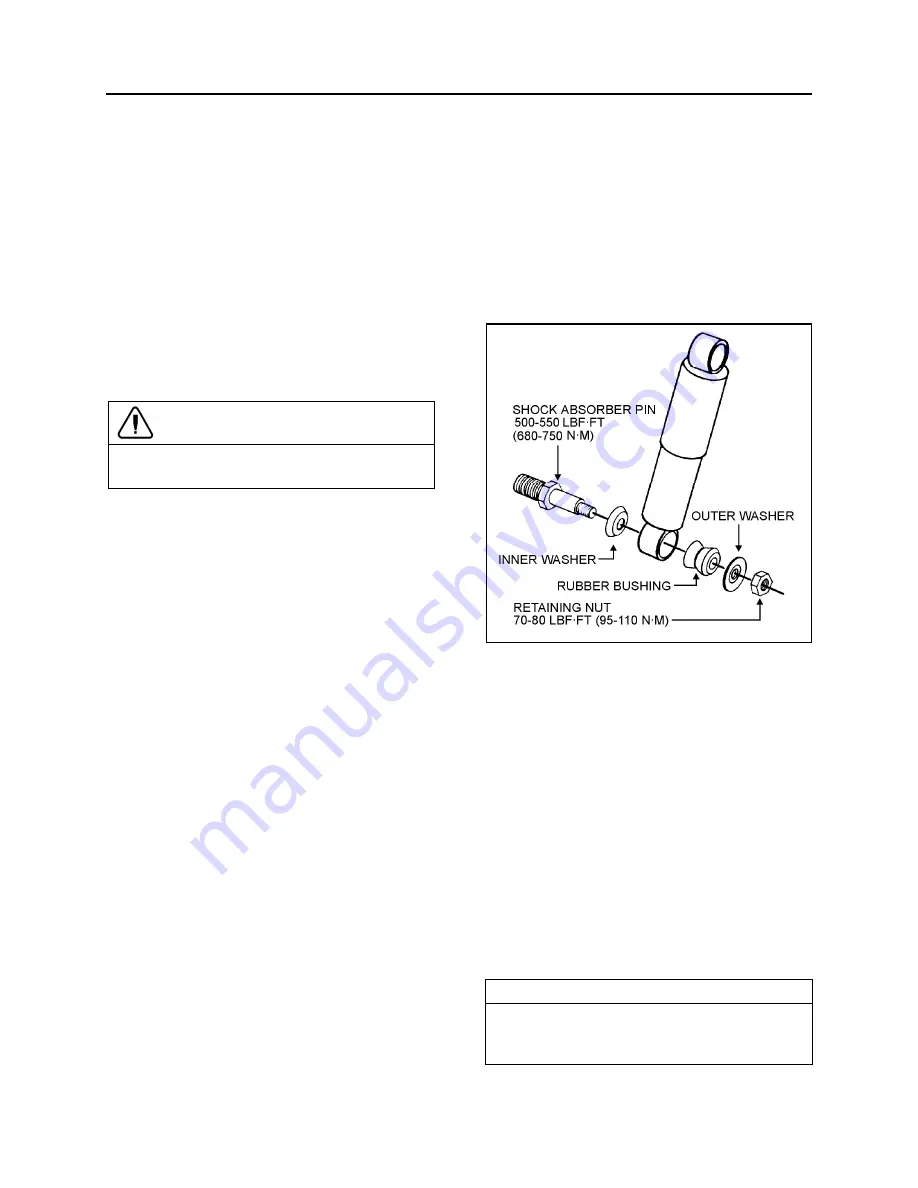
Section 16: SUSPENSION
PA1593
16
3.2.1
Inspection
Loosen lower mounting of both shocks, and then
carefully attempt to raise and lower the bottom
portion of each shock. Note the rate of effort for
distance of travel. Replace both shocks if a
definite differential rate is found.
The shock must be bench checked in an upright,
vertical position. If checked in any other position,
air will enter the cylinder tube and make the
shock absorber appear defective.
Proceed as follows to check shock absorbers:
1. With the shock absorber in a vertical
position (top end up), clamp the bottom
mount in a vise.
CAUTION
Do not clamp the reservoir tube or the dust
tube.
2. Rotate the dust tube. Notice any binding
condition (may be compared with new unit).
Binding condition indicates a scored rod.
Units with scored rods should be replaced.
3. Fully extend shocks and check for leaks in
the seal cover area. Shock fluid is a very
thin hydraulic fluid that has a characteristic
odor and dark brown tint. A slight trace of
shock fluid around the seal cover area is not
a cause for replacement. The shock seal is
designed to permit a very slight seepage to
lubricate the rod. Units that leak should be
replaced.
4. Visually check shock for dents that could
cause the shock to bind. Also, check for a
bent rod.
5. Extend and collapse shock several times to
determine that it has control (resistance) in
both rebound and compression.
6. Visually inspect the shock mountings and
vehicle mounting for:
a) Broken
mounts;
b) Extreme bushing wear;
c) Shifted bushing or sleeve;
d) Deep cracks in bushing material (shallow
surface cracks are normal);
e) Loose shock absorber pins;
f) Presence of convex washers, and their
position relative to the rubber bushing.
3.2.2
Removal
1. Remove nuts and washers from shock
absorbers on upper and lower mounting
pins, taking care to identify the inner and
outer washers to ease reinstallation. Refer
to figure 16 for details.
2. Remove the shock absorber assembly from
pins.
3. Remove the two inner bushings from the
shock absorber and discard them.
FIGURE 16: SHOCK ABSORBER
16008
3.2.3
Installation
1. Ensure that the shock absorber mounting
pins are tight and that the threads are not
stripped.
2. Install new rubber mounting bushings on
shock absorbers (upper and lower).
3. Place the inner washers (with washer
convex side facing the shock absorber
rubber bushing) on each shock absorber pin
(Fig. 16).
4. Install the shock absorber eyes over the
mounting pins, then the outer washers (with
washer convex side facing the shock
absorber rubber bushing) on each shock
extremity.
NOTE
If shock absorber pins are removed, they must
be reinstalled using “loctite” (see “Parts
Specifications” in this section).
Summary of Contents for X3-45 2016
Page 4: ......
Page 16: ...Section 00 GENERAL INFORMATION PA1593 12 FIGURE 12 METRIC US STANDARD CONVERSION TABLE 00005...
Page 17: ...Section 00 GENERAL INFORMATION 13 PA1593 FIGURE 13 CONVERSION CHART 00006...
Page 18: ......
Page 26: ......
Page 58: ......
Page 72: ...Section 04 EXHAUST AND AFTERTREATMENT SYSTEM PA1593 14 7 TORQUE SPECIFICATIONS...
Page 73: ...SECTION 04 EXHAUST AND AFTERTREATMENT SYSTEM PA1593 15...
Page 74: ...Section 04 EXHAUST AND AFTERTREATMENT SYSTEM PA1593 16...
Page 76: ......
Page 96: ......
Page 134: ......
Page 176: ...SECTION 06B ELECTRICAL 38 overcurrent working Circuit 306 shorted to ground...
Page 180: ......
Page 202: ......
Page 205: ...Section 09 PROPELLER SHAFT PA1593 3 FIGURE 1 PROPELLER SHAFT ASSEMBLY 09002...
Page 256: ......
Page 268: ......
Page 295: ...SECTION 16 SUSPENSION PA1593 9 2 5 TORQUE SPECIFICATIONS...
Page 296: ...Section 16 SUSPENSION PA1593 10...
Page 297: ...Section 16 SUSPENSION PA1593 11...
Page 314: ......
Page 380: ......
Page 388: ......
Page 413: ...Section 22 HEATING AND AIR CONDITIONING PA1593 15 FIGURE 18 REFRIGERANT CIRCUIT CENTRAL SYSTEM...
Page 433: ...Section 22 HEATING AND AIR CONDITIONING PA1593 35 FIGURE 36 CENTRAL HEATING SYSTEM COMPONENTS...






























